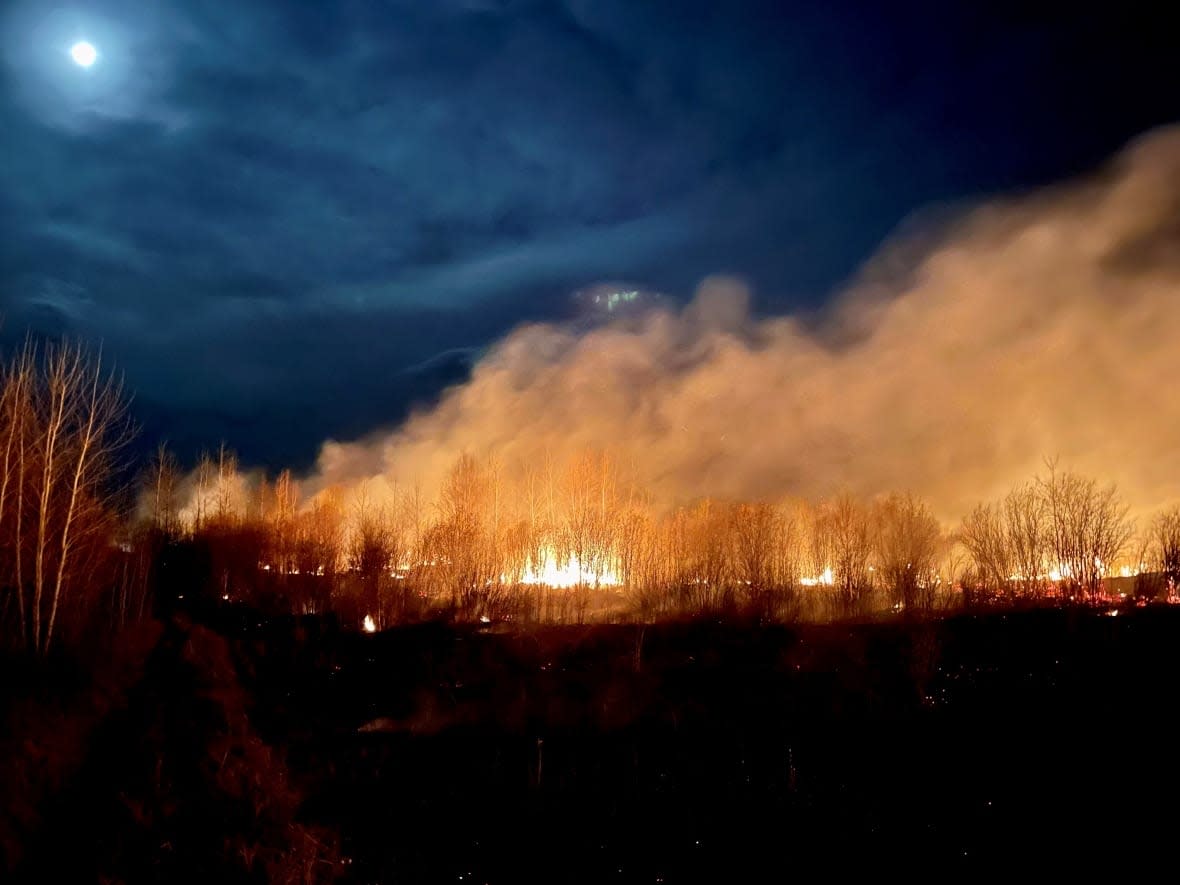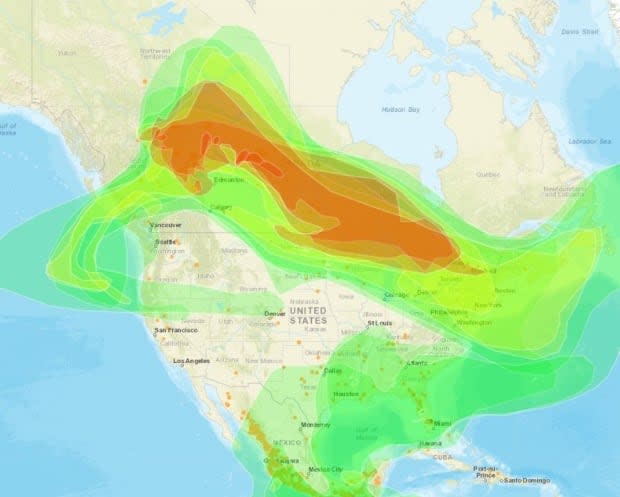Wildfire smoke blankets province as brisk winds accelerate Alberta's fire risk

As powerful shifting winds fan the flames of wildfires burning across Alberta, the fight to protect communities is becoming an increasingly unpredictable battle.
Brisk winds and punishing heat continue to escalate the risk to communities across central and northern Alberta.
On Tuesday afternoon, Alberta Wildfire information unit manager Christie Tucker said 86 wildfires are burning inside Alberta's forest protection areas, with 24 classified as out of control.
Emergency officials are cautioning that the temperamental forecast in the days ahead will escalate the risk of extreme fire behaviour and make conditions more dangerous on the ground.
Alberta Forestry, Parks and Tourism Minister Todd Loewen said volunteer firefighters may soon be able to be paid for their efforts.
"We understand with the lack of compensation for these volunteers (it) may create barriers as some may not be able to leave their regular jobs to join firefighting efforts or continue their selfless work," he said at a Tuesday news conference.
He said the province will help municipalities, First Nations and Métis settlements to cover the costs. The communities will pay, and then submit claims to the government to be reimbursed.
"Where possible, Alberta will use existing disaster assistance programs to reimburse local authorities for volunteer firefighter compensation," Loewen said.

Strong winds have brought thick smoke from the wildfires further south, blanketing communities including Edmonton and Calgary. As of Monday, as the smoke pollution spread across Alberta and beyond, special air quality statements had been issued for much of the province.
The smoke, however, isn't always an indication that a fire nearby is more active, according to Tucker.
"Smoke has actually offered some help to create cooler conditions in some areas and so far today our wildfires have been slightly less active than anticipated," she said.
"We're seeing a continuation of gusty northwest winds today that will continue to affect smoke movement in the province. Under these conditions we did see some growth on a number of wildfires yesterday, particularly in the areas north and west of Edmonton, and it's been keeping firefighters hard at work."
In some communities, including Drayton Valley, Edson and Grande Prairie, the air quality was so poor it was classified as a 10 or above on the air quality health index, the highest level of risk for air pollution.
Changing evacuation orders
Around 19,500 people have been forced from their homes, according to officials who spoke Tuesday. Military officials who briefed Prime Minister Justin Trudeau on Monday said at least 36 communities were under threat from the flames.
But some evacuees will soon be allowed to return home.
On Tuesday afternoon, an evacuation order was partially lifted for Drayton Valley and parts of Brazeau County in central Alberta, allowing a staggered re-entry for some in areas.
Adam Norris was dousing his property near Drayton Valley with water Monday morning, more than a week after fire torched his farm and land. A house, garage, vehicles, animals and irreplaceable family items were lost.
Hectares burned in Alberta wildfires
"[I'm] running on a lot of coffee and adrenalin," Norris said as he kept fighting hot spots that flared up after the hot weekend.
Kara Westerlund, a councillor and deputy reeve for Brazeau County, said driving through a burned area around town was heartbreaking.
"I grew up in that community. I have lived there over 30 years; I'm raising my family there. It takes a lot for me to cry, and both my daughter and I were bawling by the time we reached the river valley, when we saw the amount of damage and carnage that fire has done to the community," she told CBC.
"We have families — we've lost at least five homes at this point. It's absolutely devastating. I know it's just things, but when you see it, it's just — it's hard to find the words."
Evacuation orders for some parts of the County of Grande Prairie were also lifted Tuesday afternoon, with certain areas still on alert.
But in another part of northern Alberta, the town of Swan Hills issued evacuation orders Tuesday as a wildfire burned out of control to the northwest.
Roughly 1,300 residents in the town have been directed to evacuate to Barrhead, about 100 kilometres to the southeast.
Residents of Yellowhead County in west central Alberta were told to evacuate late Monday evening due to a wildfire east of Shining Bank Lake. The Holiday Inn in Edson is the emergency reception centre for those evacuees.
Earlier Monday, the town of Valleyview in northwest Alberta ordered an evacuation after a fire jumped a barrier meant to slow it down.
Evacuees were told to travel about 175 kilometres south to Whitecourt, and vehicles choked the highway Monday as the town's 1,850 residents fled.
The province also issued an official evacuation alert Monday for the Peavine Métis Settlement in northern Alberta. The community, however, had already begun evacuating on Sunday.
A fire is now burning within four kilometres of the community's homes, Gauchier said in an interview Tuesday.
He said no homes have been destroyed, but residents are anxious, hoping firefighters can hold the line.
"Yesterday was quite the day. The winds shifted down," he said. "It pushed a lot of heavy smoke into the area so the people who hadn't left yet started to panic and the ones who had were wondering if they would still have a home.
"The winds switched and they're heading south toward the community, so we are on high alert today."
While thousands of people flee their homes, sleeping in hotel rooms and reception centres, others are returning to assess the damage.
WATCH | High Level is inundated with fire evacuees:
'I wonder how we can help everybody'
About 1,000 evacuees from Fox Lake, east of High Level, are now sheltering in the nearby community of John D'Or Prairie. People have been taking shelter in the community's school and in backyards.
Two camps with enough space for 1,000 people are now being set up near the John D'Or Prairie school.
Fox Lake is one of three communities that make up Little Red River Cree Nation. The community has been hard hit by wildfires.
Dwayne Laboucan, director of emergency management for the First Nation, described the evacuation from remote Fox Lake as chaotic.
"Everyone was coming across by barge and boat," he said. "We don't have a bridge.
"If we didn't have ample time to get them across, maybe we could have lost lives because that's how bad it got."
Use the slider below to see the extent of the fire damage to the area north of Lobstick and west of Wildwood.
More than 100 structures were destroyed in Fox Lake before the fire began moving north toward the community of Garden River, another community in Little Red River Cree Nation.
Laboucan said residents of Garden River have begun to self-evacuate. The fire has not jumped the Peace River but has drawn close to the river banks and the community, he said.
Evacuees from Fox Lake are eager to return, but struggling with the news that they may not have a home when they come back, Laboucan said.
"When they got the news, they were devastated. … This is their home and they're not accustomed to leaving the community," he said.
"The wounds will be re-opened again when they see their charred homes."
The northern Alberta town of High Level has been struggling to find room for the influx of people fleeing several active wildfires in the region.
The town has faced the threat of wildfires in years past, and the community has not been spared during this unprecedented wildfire season, with several wildfires burning in the region.
High Level Mayor Crystal McAteer said it's heartbreaking to see so many evacuees flooding the town's reception centre. Residents have banded together to help them, she said.
Meanwhile, McAteer is watching the horizon day and night for signs of flare-ups and fast-moving flames. Seeing the winds shift south through the evening Monday was unnerving, she said.
"Right now, we're not under threat, but just the devastation and the traumatization of people — I wonder how we can help everybody."
WATCH | Some farmers attempt to fight wildfires on their own:


